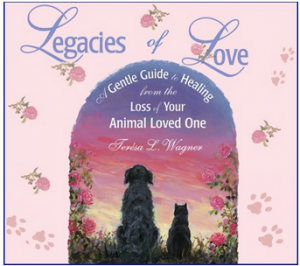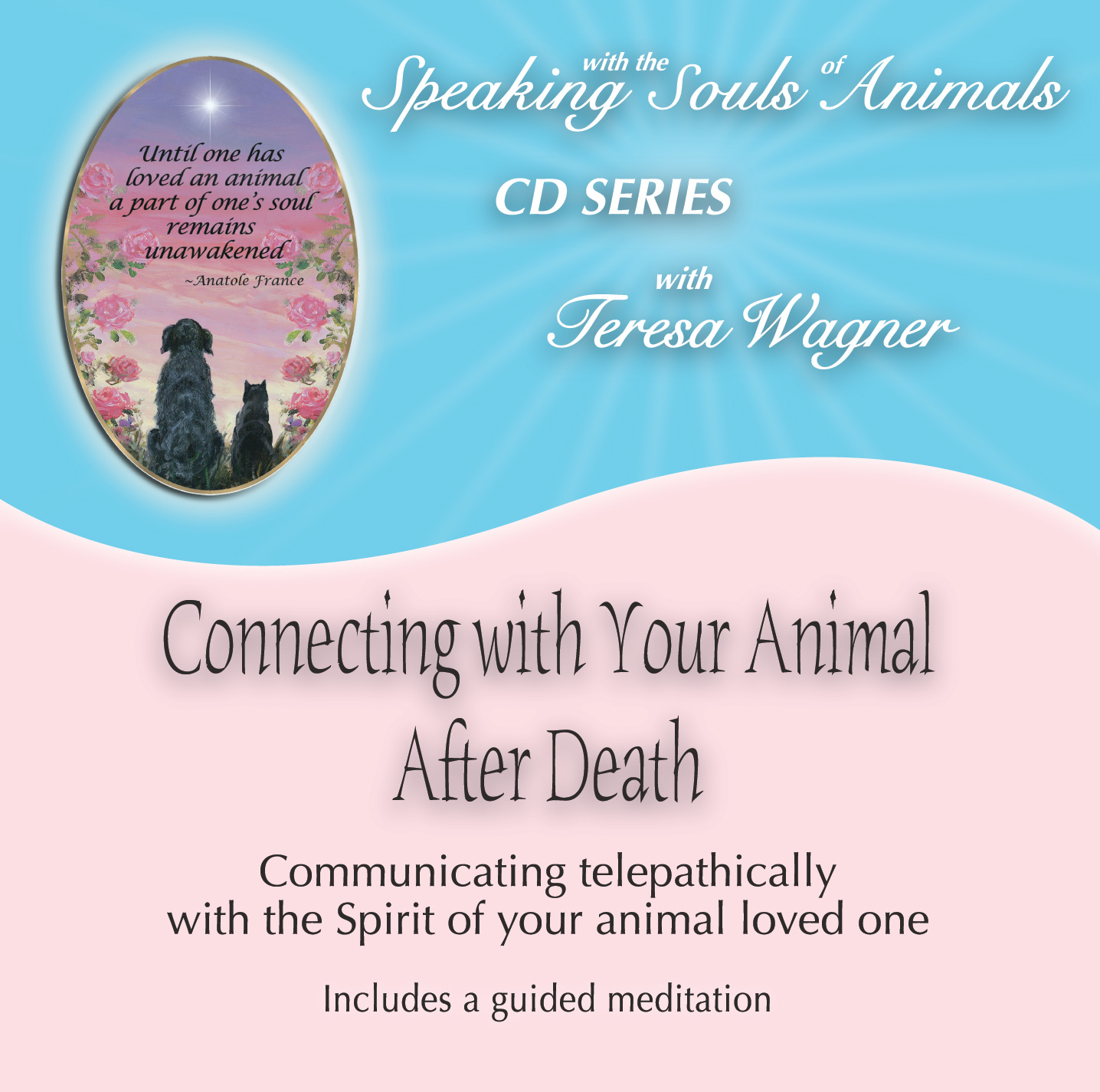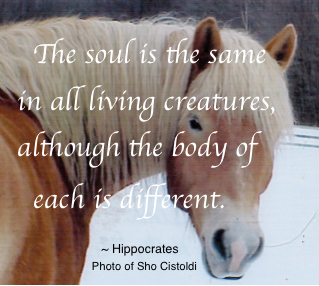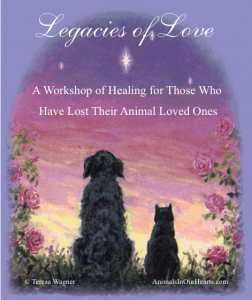Almost every client I’ve ever worked with has expressed concern about wanting a peaceful death for their animals, many doing everything they possibly could to make this happen. Overall, what animals have said they appreciated most from their people regarding their death was not necessarily whether they had help with euthanasia or not, but the extent to which their people attempted to listen and tend to their needs and desires throughout their illness and end-of-life period, and providing as much peaceful and supportive energy as possible for their actual transition and the time preceding it (of course there are deaths over which we have no control to even consider euthanasia such as vehicular accidents or predator deaths).
In her book Blessing the Bridge, filled with timeless wisdom about animal death and grief, Rita Reynolds talks about the concept of mercy: “Mercy is learning to ask for guidance, learning to listen to the other, not just myself, helping another despite my own desires and longings, and being truly willing to let go. . . Mercy might mean administering euthanasia to ease pain and suffering. Or perhaps mercy means offering that extra measure of comfort, support, encouragement, food, or medicine. To be merciful is to be soft and gentle with myself as well as with the one dying. Mercy is taking the time, making the effort to center myself and find my inner peace. Then I can be still, to listen and accept whatever the animal asks for.”
I hope that you will find some helpful and supportive information in the detailed information below with some specific things we can do toward creating a peaceful death experience for our animals:
1. Cultivate an acceptance of death as a natural part of life.
2. Cultivate a willingness to let go.
3. Make an intention to balance the pain of your anticipatory grief with being present with your animal before and during their death experience.
4. Ask your animal what they prefer at end-of-life regarding leaving on their own or with the help of euthanasia.
5. Listen to your animal using your heart and intuition.
6. Become educated about your animal’s condition, possible treatments and palliative options available.
7. Become educated about euthanasia before close to the time of death including the accurate definition and process of euthanasia.
8. Define and monitor quality of life based on factors unique to your animal.
9. Create and maintain a team of support for your animal and for you.
10. Do not let anyone pressure or bully you into a decision for or against euthanasia
11. Do not believe the myth that hospice care can never include euthanasia at the end.
Resources for Further Support
1. Cultivate an acceptance of death as a natural part of life. Although it’s understandable to resist facing the very painful and difficult truth of knowing our beloved animals are dying, resistance can actually makes us feel worse, and, make things harder for our animal. However tempting it is resist the fact that our beloved animals are dying so we can postpone the facing of the heartbreaking reality, deep down we know the truth. Whenever we deny or resist the truth, even unconsciously, this creates an anxiety within us that is actually more uncomfortable than facing the truth. Facing truth, while painful, brings a clarity in the soul that allows us to move forward with much more possibility of peace. If we have not had any prior experiences of becoming comfortable with death, or any modeling from others about how to face death with acceptance, grace and peace, it’s easier to slip into resistance. It’s challenging to learn to face and accept death. And it is normal for anyone to become overwhelmed and scared. In fear, we may resist the truth of their imminent leave taking. But we can have fears and overwhelmed even as we accept what is happening. It’s when we don’t accept death along with our fears, grief and overwhelm that we may keep a beloved animal who is suffering in their body beyond the time of what is right for them, what is fair to them.
Deep in your heart, and in your mind, try to gently open yourself to look at death in a way that allows your deep sadness and grief its rightful and necessary place, while at the same time inviting in peace and grace to help you be more able to accept your animal’s death as a natural transition in the cycle of your life together.
When a form that you have unconsciously or consciously identified with as part of yourself leaves you or dissolves, that can be extremely painful. It leaves a hole, so to speak, in the fabric of your existence. When this happens, can you face and accept that hole, that strange empty space? If you do, you may find that it is no longer a fearful place.
You may be surprised to find peace emanating from it.
Whenever death occurs, whenever a life form dissolves, God shines through the opening left by the dissolving form. That is why one of the most sacred things in life is death. That is why the peace of God can come to you through the contemplation and acceptance of death.
~ Eckhart Tolle, Stillness Speaks
2. Cultivate a willingness to let go. It’s natural for us to want to do whatever we can to help our animals live as long as possible. However, when we allow our desire for them to not die to supersede their need and readiness to die, it makes their time before death much, much harder on them. It causes them to be torn between wanting to leave a suffering body but hesitating to leave if we keep sending the message, “Don’t go! Don’t go! You can’t go!”
As deeply painful as it is to say goodbye, a gentle peacefulness can come into our hearts when we surrender to the knowledge that it is time, or soon time, to let go. Touching into that peacefulness, and feeling the anguish of anticipatory grief are not mutually exclusive. The willingness to peacefully let go can easily live side by side with our grief. This helps us say goodbye and allows us to peacefully tell our animals it is ok to go—that we will grieve but we will also heal and be alright, and that our bond of love will continue eternally, even as our physical relationship will change. Letting go in this context means letting go of the form of the relationship—the physical form—not the relationship itself. Our relationship of love will never go away, never be broken.
3. Make an intention to balance the pain of your anticipatory grief with being present with your animal before and during their death experience. When our animals are dying, the emotional pain we feel can be excruciating and overwhelming—and we deserve safe places to express our pain and receive support. It’s important for our animal’s experience that we don’t allow our grief to supersede our ability to be present with them while they are still here. They need to know that we haven’t emotionally distanced ourselves from them before they die. They need us to be present with them. We need to tell them that it’s OK to leave, that we will grieve but will be OK, and, that in the precious, limited time we have left together we will be there for them, present with them. It’s OK to cry in their presence, to be emotionally honest at all times, as long as we tell them that our tears and our pain are ours to deal with, our responsibility to tend to and heal, not theirs, and that they do not need to stay here for us. It’s not their job to fix or take care of our pain. While they are still on earth, we are still their caregiver, they are not ours.
I’ve witnessed situations with clients where a terminally ill animal has received extraordinary medical intervention to understandably try to save or lengthen their lives. Yet, when a team of veterinarians informs the client that nothing more can be done to either extend life or to keep their animal comfortable and recommend euthanasia to end their suffering, the client says they won’t accept it. This causes the animal to continue to suffer, sometimes indefinitely, because their person refuses to let go.
I’ve had a few clients in my animal communication practice (thankfully only a few) direct me to tell their animal a version of the following: “Tell him he cannot leave because I cannot live without him! Tell him he must eat all the food I give him whether he is hungry or not and must take all the medications and remedies I give him without resistance because he MUST stay alive for me! I am not ready for him to leave me.” It is certainly normal to wish that our animals could continue living for a long time, and to encourage them to eat, drink and accept medications and remedies, but to demand that they continue to live when clearly suffering is is a deeply unfair and selfish stance, one where only our needs are considered, not the needs of our animal.
A great majority of animals I’ve talked with who are near death tell me they are deeply concerned about the emotional pain their humans will experience when they leave, and it can make them hesitate to leave. Upon hearing this (and very often before hearing it), 99% of my clients have responded with tender compassion and a message to their animals that though, yes, they will be grieving deeply, but want their animals to leave when it is right for them. They don’t want their animals to stay and suffer in an attempt to protect them from their grief, and they let them know that.
When our animals are ready to die and no more medical interventions, western or holistic, are available to help to extend life or keep them out of pain, the greatest gifts we can give them are to put their needs first, to be present with them, to be willing to face and cope with our grief of letting go, and to support versus overtly resist our animals’ needed transition so they can leave their bodies in peace with our blessing.
4. Ask your animal what they prefer at end-of-life regarding leaving on their own or with the help of euthanasia. One of the most respectful things we can do for our animals is to find out directly from them what they want and then honor that. Though our own beliefs about euthanasia are surely important, this is not a decision about us, it is a decision about and for our animal. Their thoughts, their desires, and their wishes for their death experience are more important than ours. It is their death.
It’s also important to remember that just because the last animal in your life, or the last few animals, who have died were clear about wanting or not wanting euthanasia, what other animals have wanted in the past is irrelevant to what your animal in the present may want. Ask every individual animal because each animal and each situation is unique. Ask, always ask. Do you need to consult with a professional animal communicator to do this? No, not necessarily. No one knows your animal better than you do. Trust your intuitive feelings and your bond with your animal. At the same time, the strength and overwhelm of our emotions during such a challenging time can make it very hard to trust what we are receiving intuitively. When that is the case, working with a professional animal communicator can be very helpful in gathering information about your animal’s thoughts and feelings about their physical discomfort levels, how they are defining quality of life and preferences about euthanasia, so that together you can make decisions at such a difficult time. Keep in mind that it is an animal communicator’s job to help you and your animal have an interactive conversation in which you and your animal clarify what your animal wants. The role of animal communicators is not to make the euthanasia decision for you, and never, ever to tell you what to do. Their job is to tell you what your animal is saying and feeing regarding what they want, and to support both of you with the decision.
Be wary of any animal communicator (or any practitioner or author) who tells you that all animals are opposed to euthanasia. They could only know this if they asked every single animal on earth which is impossible. Such bold unsubstantiated statements indicate that the communicator is filtering what they hear through their own beliefs. Or perhaps they heard a few animals say they don’t want euthanasia and assume that such a small sample indicates a universal truth for all animals. If you are using an animal communicator, be clear that you want them to help you learn what your animal wants.
5. Listen to your animal using your heart and intuition. When you’re unsure about when they’re ready, when you’re unsure about whether they would prefer to die on their own or need help with euthanasia, talk with them. No one knows your animal like you do. We’ve all had experiences when we just know something about our animal–things that transcend observable, measurable facts.
To talk with them, to hear their messages, begin by getting yourself in a physical space where you will be uninterrupted, and free from pressures and schedules of other activities. This only need be for a few minutes if you don’t have a lot of time. Allow yourself to become quiet and still. Close your eyes. . .breathe softly. . .breath in stillness and peace. Go deep into your heart. Be in your heart, completely, filled with all the love you and your animal share. Let yourself light up with this love you have for your animal., remembering that there is more between you than impending death, that your love which transcends that. Let that love fill you and calm you, even for these few minutes. It is that love that connects you, that allows you to communicate, and it is that love which will remain beyond death. Quietly then, peacefully, with no pressure or attachment to what you may hear, ask your animal loved one what they need. Ask your questions, and listen. Gently listen. Be unattached to what you hear or perceive. Trust what you feel from them, what you hear, any images you may see. Remember that you are soul peers—you are different only in body. Speaking soul to soul, you can exchange any information, with accuracy and ease as long as it’s communicated with love and respect and no overlaying expectations. Let yourself gently listen and receive. It may not be words in full, long sentences, but a gut level clarity of what they want.
If after you’ve received a message or impression, but still feel unsure, ask your animal to send you a confirming sign in the physical world, and/or to give you clarity in you heart that is undeniable to you. Some messages are words or images and some come in the form of tremendous clarity in the heart. If you still have doubts, or want confirmation, consider seeking the help of a professional animal communicator to help you confirm or clarify your animal’s wishes.
6. Become educated about your animal’s condition, possible treatments and palliative options available. Search diligently for facts about your animals’ medical condition, diagnostics and what they mean, probable levels of pain or discomfort, conventional and holistic treatment options available, hospice care options, end-of-life choices, etc. Exploring all of this can be challenging because it requires us to pay close attention to things we wish didn’t exist. We need to learn medical facts, monitor medical conditions and look for signs of deterioration and diminished functioning we wish weren’t there. But if we don’t closely attend to these issues, out of denial, fear or overwhelm (all of which are understandable!), the price can be unnecessary or protracted suffering for our animal.
Be proactive in gathering information and guidance. It can be daunting at times going back and forth from conventional to holistic practitioners, whose opinions may be at odds and who may not respect or fully understand each others’ perspectives. This puts us as consumers in the role of having to integrate a lot of information, some of which may be contradictory or confusing. This can require a lot of work—and it is worth it.
If at any time you feel too overwhelmed to focus on all of this, a common reaction during such a stressful time, consider asking a trusted friend or family member to help you with information gathering—even part of it. In addition, it’s helpful to build positive, kind, respectful relationships with our veterinarians and holistic practitioners, including communicating respect for their training, knowledge and skill. Each person who is part of our team deserves our expressed appreciation—including our friends and/or family members.
At the same time, be careful to not delegate full responsibility for the euthanasia decision to any of them. The choice and timing for euthanasia is a decision between you and your animal and your veterinarian’s medical expertise and information.
7. Become educated about euthanasia before close to the time of death including the accurate definition and process of euthanasia. The literal definition of euthanasia is “good death” and is chosen as an act of love and compassion to stop or prevent further suffering. It is the act of inducing a dignified and painless death for reasons of mercy and compassion. It is not killing—which is done for sport, for murder with malice, killing for food and sometimes by accident. Killing has nothing to do with mercy, compassion or love. Euthanasia has everything to do with mercy, compassion and love–the foundation of the decision.
Ask your veterinarian about their specific procedures for euthanasia, including whether they will come to your home and whether they offer cremation services if that is something you want. If you want an at-home euthanasia and your veterinarian does not provide this service, research those who do provide it in your area. Consider whether you and your animal prefer burial or cremation, and what arrangements and costs are associated with each. Though it is helpful to consider this for all of our companion animals, it can be especially important to research ahead of time for horses, even more so if you live in a winter climate where the ground freezes. Doing all of this as far in advance as possible can prevent a lot of stress near the time of death. It allows us to use our energy to be present with our animal rather than spending that precious time on logistics.
Windi Wojdak, RVT, Director of Rural Area Veterinary Services for HSUS, tells us in her class Understanding and Preparing for Euthanasia:
“In the right time and circumstances, providing a peaceful release for an ailing companion through euthanasia can be a powerful demonstration of love and respect. Education about the process of euthanasia can help us prevent surprises and minimize discomfort, stress or shock that can be part of the experience for humans saying goodbye to their animal companions. Advanced planning and consideration of our own questions, concerns, fears and beliefs about euthanasia can help us to make more informed decisions and create the best death experience possible for our animals. If we are able to move past our own fears and take charge of our animal’s death, euthanasia can become a sacred act and a time of powerful connection.”
Knowing we made sure we were as well informed as possible about euthanasia before our animal’s death can help us experience the process with more peace, and can eliminate or minimize guilt afterwards.
8. Define and monitor quality of life based on factors unique to your animal. Quality of life measurement charts such as that of the pioneering work of Dr. Alice Villalobos, veterinary oncologist and founder of Pawspice, can be a very helpful tool to help us assess our animal’s quality of life day by day. However, the definition and measurement of quality of life for a given animal at any given time is not a one size fits all situation. It is unique to every animal. The Villalobos scale measures important factors such as Hurt (pain), Hunger, Hydration, Hygiene, Happiness, Mobility and More God Days Than Bad. It’s important that we carefully define such factors, and any additional factors, as relevant to the distinct needs of our animal. Keeping a journal or chart to help us see how quality of life factors change over time can be extremely helpful. Sometimes those changes occur in a gradual, subtle manner, so keeping a written record helps us track the changes we may have missed if not written down. It can also be helpful to take photos every week, or more often, for the same reasons. It can be enormously helpful to have these written observations, and perhaps images, to share with our veterinarians, healers and /or other practitioners for consideration of medications, remedies, processes, etc., and to help us make a more informed decision about the timing of euthanasia if that will be involved.
9. Create and maintain a team of support for your animal and for you. You might think of it as a sacred circle of support, including:
Direct support for your animal. Cherish and value the help from medical professionals, both veterinarians and holistic practitioners if you use them. Research which practices and practitioners are known to help your animal’s situation from conventional treatment to homeopathy, energy healing, acupuncture, herbs and supplements, animal communication, etc.
Support with practical matters. If you are blessed with friends or family willing to support you, consider asking for help for things such as: Driving you and your animal to appointments so you can hold your animal every moment during the drive; picking up medications, special foods or other errands; being with you during vet visits to take notes or ask questions about things you may miss due to being understandably upset; researching veterinarians who do in-home euthanasia—including what days of the week, times they provide this service and the fees; finding resources for cremation or burial including costs and timing; pet sitting when you may need a break from the intensity of hospice care to have even a little time for self care, or, just to give the other animals in your family some extra attention which they may be craving while the animal who is ill may understandably be receiving so much added attention.
Emotional support. We can all be helped to have people who will be there to listen and care when you are upset or overwhelmed. Perhaps one friend may be too far away geographically to provide in person support, but can be there for you to listen by phone, text or email; perhaps to pray for you and just to let you know that they care. Those supporting you may include people on an online support group—people you don’t socialize with but people who really get what you are going through, providing a rewarding opportunity for mutual support and understanding. And when we are lucky, we have family and/or friends who love us and our animal dearly and are there for us through the entirety of the experience, including perhaps being there at the time our animals are euthanized. Ask the people who love you for support.
Spiritual Support. Take solace in your spirituality and the spiritual practices which bring you comfort and meaning. Connect with God, however you define or experience the divine, a higher power or spiritual beings you know are supporting you. Ask for help in making the best decision in the right timing so your animal does not suffer. Ask the spiritual beings you pray to, including perhaps your animal and human loved ones on the other side to be there to meet your animal’s spirit as they leave their body. Ask for help in letting go, in saying good-bye, in accepting their physical death. Ask for help to ease your own emotional pain. It is not selfish to do so. The transition of death is much, much harder on the people left behind than the animals leaving their bodies. You deserve support, understanding, and love. Try to spend time with people (even if just one person) who shares your spiritual beliefs, and spend time in places that bring forth the strength and support of your spiritual beliefs such as special places in nature, church, supportive books, guided meditations, etc.
10. Do not let anyone pressure or bully you into a decision for or against euthanasia. The decision for euthanasia is a private issue, a decision made between a person and their animal —and of course informed by medical information—with each situation being unique. If you feel you need even a little time to step back before making your decision, by all means do so (except, of course, in situations that require immediate action to end acute suffering), during which time you can continue to check with your animal, your intuition, and all the beings on your support team.
Some people feel that only natural death is ethical, when in fact for some animals, dying on their own may prolong or create unnecessary suffering. On the other end of the spectrum there are some animal guardians so uncomfortable with what can be overwhelming feelings of anticipatory grief during what can be a prolonged period of hospice that euthanasia might be chosen prematurely, before medically necessary, so the animal guardian does not have to face and live with their uncomfortable feelings.
Be very careful to not allow people with strong or inflexible, uncompromising opinions about either end of the spectrum overly influence you. Rather than make the manner of death a fixed, rigid decision or a political issue (i.e., only one way is the right way!) we can make the most informed decision that is best for our animal and their unique situation by listening to our animal, a trusted veterinarian, and our own heart.
11. Do not believe the myth that hospice care can never include euthanasia at the end. The hospice period is defined by when we have consciously moved from curative care to comfort care. Some people rigidly believe that hospice care can never include euthanasia even if suffering levels are unbearable for the animal near the end. Others, most of us I think, want a peaceful and painless death for our animals. Such a peaceful and painless death after a period of compassionate hospice care, may happen with euthanasia, or without euthanasia.
Some people are deeply committed to having a “natural” death for their animals and are morally opposed to euthanasia. If this may be your belief, and you also want your animal to have a peaceful and painless transition and death, I encourage you to carefully consider the extent to which any pain and suffering your animal may be experiencing (that can no longer being kept at bay with holistic or conventional remedies) before deciding against euthanasia under any circumstances.
Saying good-bye to our animals at death need not be a solely negative experience. While it will likely always be deeply emotionally painful, it can also be a poignant, intimate, loving time of gratitude, peace and grace. Your relationship with animals is a blessing of love. Cherish it, and know that along with your power to love so deeply, you also have the power of courage to both say good-bye and to heal from your grief.
Resources for Further Support:
In Home Euthanasia (if you own trusted veterinarian does not provide this service)
Lap of Love Veterinary Hospice
which provides many end-of-life educational resources, and in-home euthanasia service.
https://www.lapoflove.com/our-services/in-home-euthanasia
Books
• Blessing the Bridge—What Animals Teach Us About Death, Dying, and Beyond,
Rita Reynolds New Sage Press 2001
• One You Love is Dying—12 Thoughts to Guide You on the Journey, James Miller
Willowgreen Publishing 1997
• Hospice and Palliative Care for Companion Animals Principles and Practice, 2nd Edition
Amir Shanan, Jessica Pierce Wiley-Blackwell 2023
Flower Essences Available from fesflowers.com
• Compassionate Care Giver: Helps one stay present, feel less stress and more calm and centeredness with the overwhelm of both practical physical care and emotional support required in such situations.
• Peace-Full Passage: Promotes a sense of deep peace for those nearing or in transition from the body to the spirit world.
• Grief Relief: This formula gently and powerfully bring relief to our feelings of grief no matter what “phase” of our healing we may be in on a given day or moment, i.e., moderate sadness to staggering, overwhelming pain
• Forget-Me-Not: deepens our awareness of our spiritual connection with loved ones who have physically died and helps us develop telepathic communication with them.
• Chrysanthemum: Helps us accept the transitory nature of earthly life and helps us heal any fears and/or avoidance of physical death.
Articles
A Meditation Process to Connect with Your Animal During Illness and After Death
When our beloved animals are very ill, or have already left their physical bodies, it can be quite meaningful and healing to connect with them at the deepest level of their soul, to communicate with them telepathically from the deepest level of our emotional hearts.
Guided Meditation
Connecting with the Soul of Your Animal After Death
Similar to but much more detailed than the article above, this meditation is more thorough and includes a guided meditation with soft music:
Track 1: Discussion of how to prepare oneself for connecting telepathically with a beloved animal after death
Track 2: A guided meditation to help make that connection
Class
Understanding and Preparing for Euthanasia
For anyone who would like to reduce the anxiety and stress (for themselves and their animals) related to end-of-life decisions by increasing their education to better understand the euthanasia process.
Class
Understanding and Preparing for Euthanasia
For anyone who would like to reduce the anxiety and stress (for themselves and their animals) related to end-of-life decisions by increasing their education to better understand the euthanasia process.
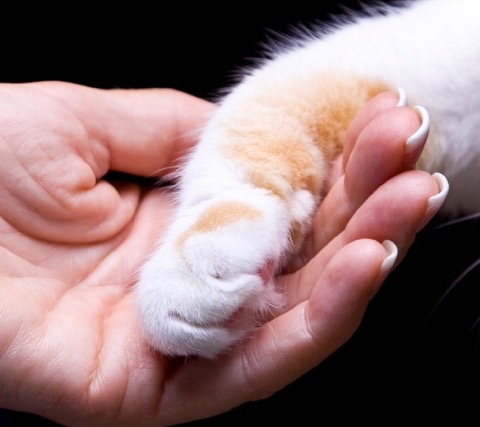
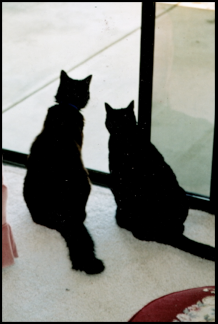

 Thank you for visiting my blog. It is a place for me to share stories from and about animals, love, loss and healing. The articles are primarily written by me, but some are from my colleagues who have graciously allowed me to share their words here.
Thank you for visiting my blog. It is a place for me to share stories from and about animals, love, loss and healing. The articles are primarily written by me, but some are from my colleagues who have graciously allowed me to share their words here. 